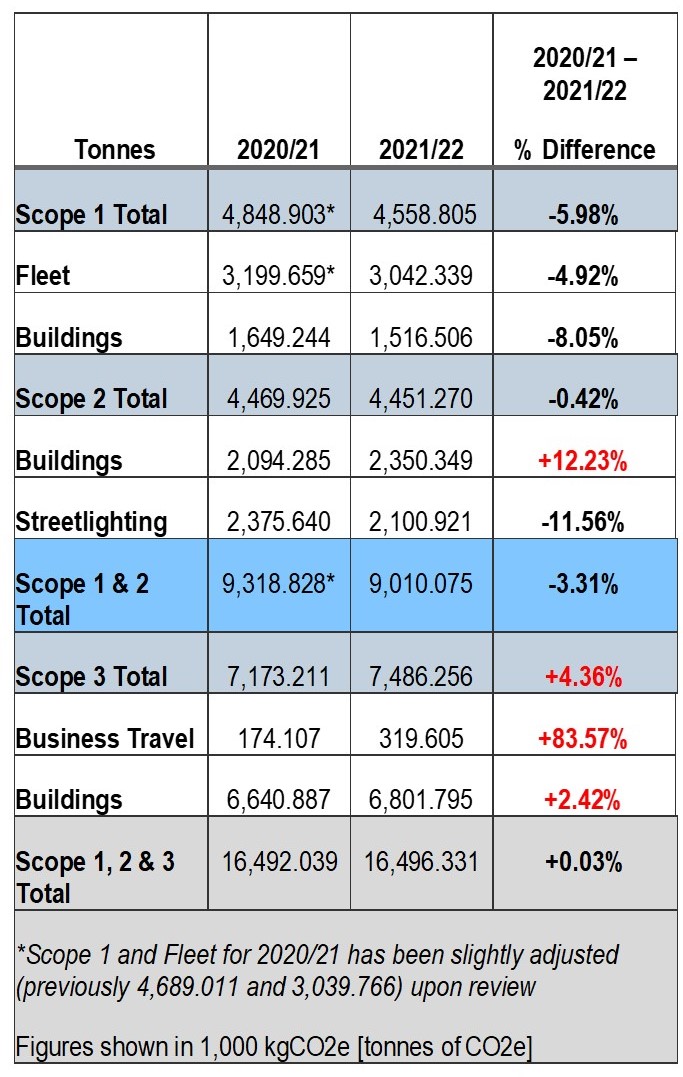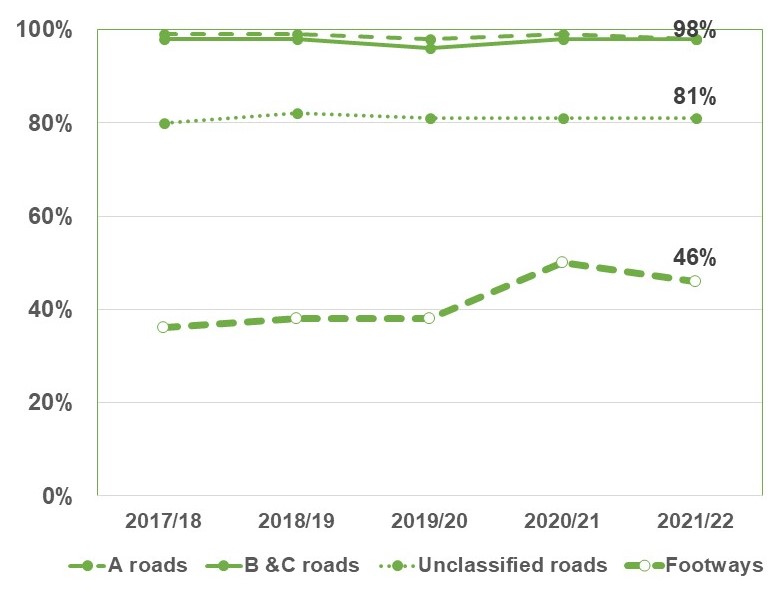Low emissions pathway
Council’s carbon emissions
Over the past year, the city’s total carbon emissions have slightly increased, primarily owing to recovery from the COVID-19 pandemic.
The carbon emissions are broken down into scopes 1, 2 and 3 emissions, the definition of which are:
Scope 1 direct emissions: activities owned or controlled by your organisation that release emissions straight into the atmosphere. Examples: emissions from combustion in boilers we own, emissions from owned or controlled vehicles.
Scope 2 energy indirect emissions: released into the atmosphere associated with the consumption of purchased electricity, heat, steam, and cooling. The most common type of Scope 2 emission is electricity purchased from the National Grid.
Scope 3 other indirect emissions: those at sources which we do not control, and which are not classified as scope 2 emissions. Examples of scope 3 emissions include business travel not owned or controlled by the Council (e.g., use of public transport), commuting, or use of ‘grey fleet’ (employees’ own cars used for fuel expenses).
There is a slight increase in overall carbon emissions of around 0.03% but the data shows that a significant percentage of this increase has come from consumption of heat and electricity (Scope 2) and business travel (Scope 3), which was to be expected with recovery from the pandemic. This is because since lockdowns have ended, people are travelling for work and meetings again and similarly, office buildings are back in use. Scope 1 emissions have seen a reduction, both in council-owned buildings as well as for fleet. The reason for the decrease in building emissions is partly because of the removal of gas oil consumers (such as Whitley Depot Admin Block and the COVID-19 test centres at Moat Street Leisure Centre) this year, as well as the PSDS scheme which has introduced more heat pumps, solar panels and insulation retrofit. For fleet, a quieter gritting season as well as the fuel-crisis around October contributed to the fall in emissions.
Carbon disclosure
The CDP (formerly known as the Carbon Disclosure Project) is an internationally recognised benchmark that helps companies and cities disclose their environmental impact.
The Council is currently achieving a “B” CDP score; and the One Coventry Plan has a target of achieving an “A” score.
Supporting businesses
The Coventry & Warwickshire Green Business Programme supports the shift towards a low carbon economy, delivering a cohesive package of support activities to small and medium enterprises (SMEs) with fewer than 250 employees that facilitate economic growth through SMEs developing and adopting energy and resource efficiency measures, as well as renewable energy. Originally launched in 2016, the Programme was the first integrated package of business support focused on the low carbon agenda and reduction of business carbon emissions that the Council has delivered, and the first such programme in Coventry & Warwickshire.
Coventry City Council provide grants (£1k-£50k based on an intervention rate up to 40%), free energy and resource efficiency audits and a Green Business Network to maximise the energy efficiency and low carbon opportunities of SMEs based in Coventry and Warwickshire. SMEs engaged in the Programme experience a variety of benefits, including reduced energy bills, maintenance costs, waste disposal costs and carbon emissions and increased competitiveness, efficiency, and improvement to working conditions. Since the start of the Programme, we have supported over 288 businesses; saved over 13,595 tonnes CO2 annually; created a network of 1,950 members; supported the creation of 60 jobs; and paid over £2.78m in funding.
Road network quality
Better roads reduce wear and tear on tires, which is a significant source of air particle and microplastic pollution. Better pavements and better cycle routes enable low-cost physical access through active travel options such as walking and cycling.
The 2021/22 survey shows 98% of A roads and B & C roads, as well as 81% of unclassified roads, to be in a good/acceptable condition. However, this is much lower at 46% for footways. The condition of cycleways is currently measured as forming part of a roadway or a footway.
The Council is working on improving its footways – this year’s data has shown a 4% decrease – however this is thought to reflect increased monitoring of more footway sites: national reporting standards only cover high hierarchy footways (school, shopping areas and main routes) and historically this is all we surveyed (on a four-year cycle). We now survey 100% of footways over a four-year cycle. Most of the network will be covered by the end of the 2022/23 survey period.
Fewer priority potholes
985 “priority 1” potholes were reported in the financial year 2021/22, down from 1,339 in 2020/21. This is a decrease of 354 over the 12-month period. This large reduction may be down to a milder than average winter period.
From February 2022 potholes in Coventry will be repaired and fixed permanently in super quick time after Highways Service purchased JCB’s revolutionary pothole machine, “PotholePro”. The PotholePro can repair a pothole in less than eight minutes. The Council took part in a trial demonstration on Abbey Road, Coventry last summer where the machine repaired more than 100 m of patches in the road in just two hours. A stretch of road that usually takes four days to repair. After closely monitoring the potential impact on road repairs the Council ordered the machine and it is now working on city roads. The JCB PotholePro breaks the road and cleans the hole, without the need for any hand working, so a permanent repair can be carried out.
Road treatment programmes
In 2021/22, 18 miles of carriageway were treated, and 50 footway sites were improved. This is a reduction from the 65 footway sites improved in 2020/21 when we received additional Department for Transport challenge fund monies for footway improvements.
In 2021/22 £4,455,000 was spent from the previous DfT challenge fund bid for Swanswell Viaduct works.
Zero carbon vehicles
The Council has significantly increased the number of electric fleet vehicles over the past year. By March 2022, we had 72 zero carbon vehicles. This an increase from 4 vehicles in March 2021.
We have now been successful in replacing most of our cars and smaller vans with electric alternatives. We have also replaced the mayor’s civic car with an electric car and will take delivery of our first electric heavy goods vehicle, an 18-tonne gully tanker in June 2022.
Charging points
There are 438 charge points operational as of 28 March 2022 in Coventry. The ratings of these charge points vary from 3kW to 22kW.
20 x 7kW charge points are in Salt Lane car park; 16 x 7kW in the Station Multi Storey car park; and 402 charge points with varying rating (3kW to 22kW) in residential areas under the on-street residential charge point scheme.





